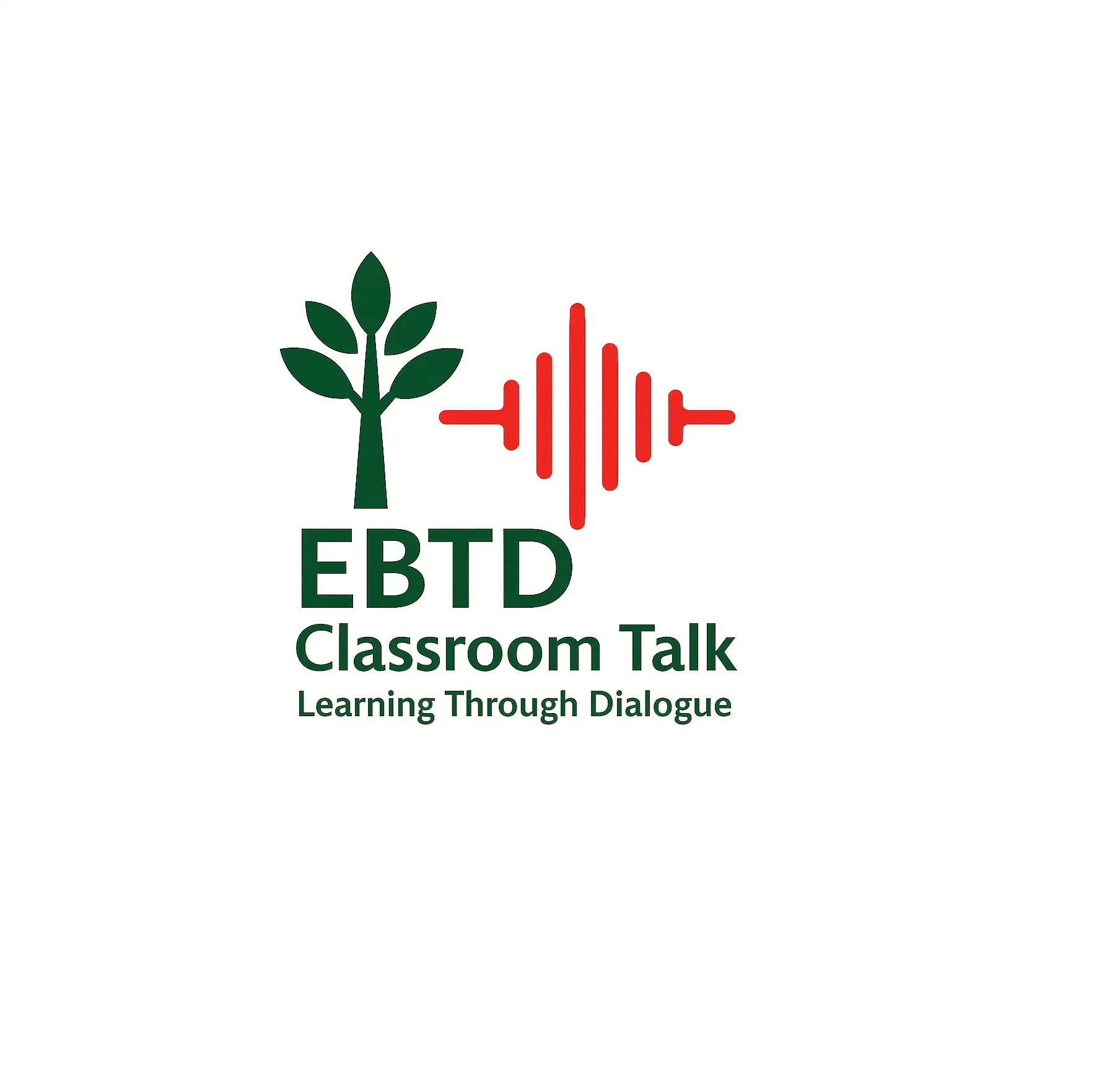
EBTD Guide to Student Discussion & Classroom Talk
From Silence to Thinking — Building Classrooms Where Every Voice Matters
EBTD Guide to Student Discussion & Classroom Talk
From Silence to Thinking — Building Classrooms Where Every Voice Matters
The Challenge We Face
Walk into a typical classroom in Bangladesh and you’ll hear a familiar rhythm — the teacher explaining, students listening, heads down, pens moving. It’s ordered, respectful, and focused. But it’s also one-directional. Students rarely ask questions or discuss ideas with each other. Learning becomes about remembering, not reasoning.
Research from BRAC IED, CAMPE, and university studies across Dhaka, Chattogram, and Rajshahi shows that classroom interaction in Bangladesh remains dominated by lecture and recall, with limited student dialogue or problem-solving. Large class sizes, fixed seating, and exam-driven expectations make it difficult for teachers to invite open talk.
Yet, where schools have tried — even in small ways — the results have been remarkable. Inquiry-Based Learning pilots in Dhaka (2025) found that when students had regular opportunities for structured discussion, they became more confident, collaborative, and better able to explain their reasoning. Talk isn’t noise. Talk is thinking made visible.
Why Talk Matters
The science of learning is clear: students don’t fully understand something until they can explain it. That act of saying what they know and why they know it builds memory, metacognition, and transfer — the hallmarks of deep learning.
Research from Neil Mercer, Robin Alexander, and the EEF shows that dialogue in the classroom improves:
- Reasoning and problem-solving
- Self-regulation and motivation
- Language, vocabulary, and confidence
For teachers, classroom talk becomes a formative mirror — letting you hear misconceptions and adapt your teaching. For leaders, it becomes a culture of thinking — one where learning is built through conversation, not silence.
Two Audiences, One Mission
This guide is written for everyone working to improve classrooms in Bangladesh — from the lone teacher trying something new tomorrow, to leadership teams building a culture of active learning across their school.
If you’re a teacher…
You’ll find routines, prompts, and lesson designs that make talk possible — even in crowded rooms.
If you’re a school leader…
You’ll find frameworks, CPD ideas, and review tools for developing a school-wide culture of purposeful discussion.
Both journeys meet at the same goal: students who think aloud, teachers who listen deeply, and schools where dialogue drives learning.
What You’ll Find Inside the Guide
- The Current Reality – What Research Tells Us About Talk in Bangladeshi Classrooms
A clear-eyed evidence review: what the studies show, what’s blocking change, and why it matters. - Structure First – Making Talk Physically Possible
How seating, layout, and movement shape participation — with visual examples and routines for “Home” and “Active” modes. - Modelling Talk – Teaching Students How to Learn Through Dialogue
Sentence stems, routines, and talk frames that build confidence and respectful listening. - Lesson Design for Thinking Talk – Planning, Dialogue, and Metacognition in Action
How to embed purposeful discussion into lessons and help students use talk to plan, monitor, and reflect on their own learning. - Leadership & Culture – Growing a School That Values Talk
How leaders can create professional dialogue, support coaching, and normalise evidence-led reflection. - Implementation Roadmap – A Practical Plan for Change
How to lead this shift step by step, measure progress, and sustain new habits across your school.
Each section includes:
- Evidence summaries (global and Bangladesh)
- Practical tools (routines, posters, templates)
- Reflection questions for teachers and leaders
- Downloadable planning sheets for CPD and classroom use
What About the Early Years?
Talk begins long before formal schooling. In the early years, conversation through play, story, and imagination builds the foundations of thinking aloud. Young children learn by narrating their actions, explaining choices, and listening to others.
That’s why EBTD has created a dedicated annex: Talk in the Early Years – Foundations for Thinking Aloud. It shows how playful dialogue grows into structured talk routines in primary and beyond — bridging curiosity, language, and reasoning.
In later stages (Primary to A-Level), the same principles apply but the complexity of questioning, task structure, and independence increase. Short, guided exchanges in primary evolve into open-ended reasoning and debate by A-Level — the same bridge, just further across.
Hear from the Team
In this short video, the EBTD team share why Classroom Talk sits at the heart of meaningful learning. They explore how structured dialogue, questioning, and student voice can turn lessons from teacher-led to thinking-led — helping Bangladeshi classrooms become places where ideas are built, not just repeated.
Frequently Asked Questions
Answers to key questions about Classroom Talk — why it matters, what the evidence shows, and how teachers and leaders in Bangladesh (BD) can make dialogue a practical reality in every classroom.
What is the EBTD Guide to Classroom Talk?
It’s a free, research-based guide that helps teachers and leaders in Bangladesh build classrooms where thinking happens aloud. It brings together evidence, routines, and tools to move lessons from lecture-led to dialogue-led—without losing structure or control.
Why focus on classroom talk?
Because talk is thinking made visible. Research from BRAC IED, CAMPE, and international studies shows that when students explain ideas aloud, they develop reasoning, vocabulary, and confidence. For teachers, it’s a window into student understanding; for students, it’s the bridge between memory and meaning.
What problem does the guide address?
In many BD classrooms, lessons are respectful but one-directional—teachers talk, students listen. Studies show teacher talk can occupy 75–85% of lesson time. The guide tackles this imbalance by providing practical ways to make structured dialogue possible, even with large classes and fixed seating.
How is the guide structured?
It’s organised into six linked sections: – The Current Reality – what evidence from BD schools shows – Structure First – how seating and layout enable participation – Modelling Talk – teaching students how to discuss respectfully – Lesson Design for Thinking Talk – embedding discussion in planning – Leadership & Culture – creating whole-school habits – Implementation Roadmap – a plan for sustainable change.
Is it realistic for large Bangladeshi classes?
Yes. The guide was written for real BD classrooms—often 40–60 students, fixed benches, and exam pressure. It offers doable routines (like “Home” and “Active” modes) that make talk possible without rearranging the entire room.
What kind of evidence supports these ideas?
It draws on global research (Neil Mercer, Robin Alexander, EEF) and Bangladeshi studies from BRAC IED, CAMPE, and universities. Together they show that purposeful talk improves reasoning, self-regulation, vocabulary, and teacher responsiveness.
What practical tools are included?
Sentence stems, talk frames, layout diagrams, planning templates, and observation checklists. Each tool is designed to be low-cost, high-leverage — helping teachers and leaders build talk routines step by step.
Who is the guide for?
Both teachers and leaders. Teachers can use the routines immediately; leaders can use the framework for professional development, lesson observation, and coaching. Both aim for classrooms where students think, not just listen.
Does it include early years guidance?
Yes. The Early Years Annex – Talk in the Early Years shows how playful dialogue and story-based conversation lay the foundation for later reasoning and discussion. It connects early curiosity to structured classroom dialogue in primary and beyond.
How can leaders use this to change school culture?
The guide’s Leadership & Culture section explains how to embed talk in CPD, coaching, and review systems. Leaders can use it to start professional dialogue, set shared expectations, and model reflective practice across teams.
What is the Implementation Roadmap?
A simple, staged plan for change—helping schools move from individual experimentation to whole-school routines. It includes milestones, evidence signals, and suggested timelines for sustainable implementation.
Is the guide free?
Yes. The entire Guide to Classroom Talk and Early Years Annex are free to read and use from the EBTD Research Hub. They form part of EBTD’s mission to support evidence-based teaching across Bangladesh.
How does this connect to EBTD’s training?
The guide complements EBTD’s teacher and leadership training modules. Schools can request CPD sessions or coaching support on dialogue, questioning, or talk-based lesson design to embed these ideas into practice.
How do we start?
Begin by reading The Current Reality section and trying one small routine—such as a paired reasoning prompt or the “Active Mode” seating switch. Contact EBTD to explore training or implementation support for your school.
Our Starting Point
Before we can change classroom talk, we need to understand what’s really happening inside Bangladeshi classrooms today.
The research paints a clear picture: teacher talk dominates, student voices are limited, and discussion — when it happens — is often short, unstructured, and low-stakes. But it also shows that even modest, well-planned shifts — new seating routines, talk scaffolds, or lesson designs — can dramatically improve engagement and learning.
Next: The Current Reality — What Research Tells Us About Talk in Bangladeshi Classrooms
If you found this useful, join the EBTD newsletter for monthly, research-backed tips, free classroom tools, and updates on our training in Bangladesh — no spam, just what helps.
